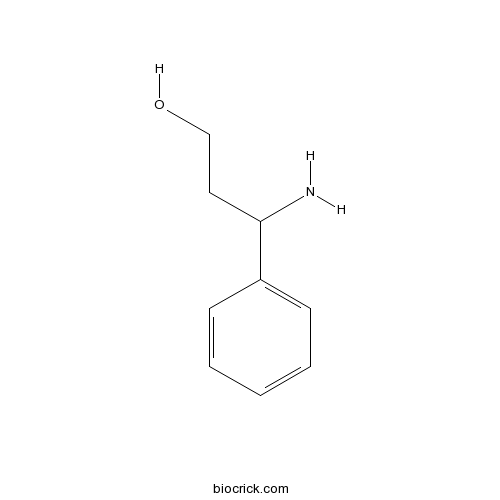3-Amino-3-phenyl-1-propanolCAS# 14593-04-5 |

Quality Control & MSDS
3D structure
Package In Stock
Number of papers citing our products

| Cas No. | 14593-04-5 | SDF | Download SDF |
| PubChem ID | 203500 | Appearance | Powder |
| Formula | C9H13NO | M.Wt | 151 |
| Type of Compound | N/A | Storage | Desiccate at -20°C |
| Solubility | Soluble in Chloroform,Dichloromethane,Ethyl Acetate,DMSO,Acetone,etc. | ||
| Chemical Name | 3-amino-3-phenylpropan-1-ol | ||
| SMILES | C1=CC=C(C=C1)C(CCO)N | ||
| Standard InChIKey | SEQXIQNPMQTBGN-UHFFFAOYSA-N | ||
| Standard InChI | InChI=1S/C9H13NO/c10-9(6-7-11)8-4-2-1-3-5-8/h1-5,9,11H,6-7,10H2 | ||
| General tips | For obtaining a higher solubility , please warm the tube at 37 ℃ and shake it in the ultrasonic bath for a while.Stock solution can be stored below -20℃ for several months. We recommend that you prepare and use the solution on the same day. However, if the test schedule requires, the stock solutions can be prepared in advance, and the stock solution must be sealed and stored below -20℃. In general, the stock solution can be kept for several months. Before use, we recommend that you leave the vial at room temperature for at least an hour before opening it. |
||
| About Packaging | 1. The packaging of the product may be reversed during transportation, cause the high purity compounds to adhere to the neck or cap of the vial.Take the vail out of its packaging and shake gently until the compounds fall to the bottom of the vial. 2. For liquid products, please centrifuge at 500xg to gather the liquid to the bottom of the vial. 3. Try to avoid loss or contamination during the experiment. |
||
| Shipping Condition | Packaging according to customer requirements(5mg, 10mg, 20mg and more). Ship via FedEx, DHL, UPS, EMS or other couriers with RT, or blue ice upon request. | ||

3-Amino-3-phenyl-1-propanol Dilution Calculator

3-Amino-3-phenyl-1-propanol Molarity Calculator
| 1 mg | 5 mg | 10 mg | 20 mg | 25 mg | |
| 1 mM | 6.6225 mL | 33.1126 mL | 66.2252 mL | 132.4503 mL | 165.5629 mL |
| 5 mM | 1.3245 mL | 6.6225 mL | 13.245 mL | 26.4901 mL | 33.1126 mL |
| 10 mM | 0.6623 mL | 3.3113 mL | 6.6225 mL | 13.245 mL | 16.5563 mL |
| 50 mM | 0.1325 mL | 0.6623 mL | 1.3245 mL | 2.649 mL | 3.3113 mL |
| 100 mM | 0.0662 mL | 0.3311 mL | 0.6623 mL | 1.3245 mL | 1.6556 mL |
| * Note: If you are in the process of experiment, it's necessary to make the dilution ratios of the samples. The dilution data above is only for reference. Normally, it's can get a better solubility within lower of Concentrations. | |||||

Calcutta University

University of Minnesota

University of Maryland School of Medicine

University of Illinois at Chicago

The Ohio State University

University of Zurich

Harvard University

Colorado State University

Auburn University

Yale University

Worcester Polytechnic Institute

Washington State University

Stanford University

University of Leipzig

Universidade da Beira Interior

The Institute of Cancer Research

Heidelberg University

University of Amsterdam

University of Auckland

TsingHua University

The University of Michigan

Miami University

DRURY University

Jilin University

Fudan University

Wuhan University

Sun Yat-sen University

Universite de Paris

Deemed University

Auckland University

The University of Tokyo

Korea University
- 7,8,9,9-Tetradehydroisolariciresinol
Catalog No.:BCN1649
CAS No.:145918-59-8
- CGP 53353
Catalog No.:BCC7363
CAS No.:145915-60-2
- CGP 52411
Catalog No.:BCC7667
CAS No.:145915-58-8
- Brachynoside
Catalog No.:BCN3749
CAS No.:145898-87-9
- D-myo-Inositol-1,3,4,5-tetrakisphosphate, octapotassium salt
Catalog No.:BCC7058
CAS No.:145843-69-2
- Tiagabine hydrochloride
Catalog No.:BCC5217
CAS No.:145821-59-6
- Margatoxin
Catalog No.:BCC7709
CAS No.:145808-47-5
- G-749
Catalog No.:BCC4009
CAS No.:1457983-28-6
- 4,6-Dichloro-2-(propylthio)pyrimidin-5-amine
Catalog No.:BCC8666
CAS No.:145783-15-9
- 4,6-Dichloro-5-nitro-2-propylthiopyrimidine
Catalog No.:BCC8667
CAS No.:145783-14-8
- AR-C 66096 tetrasodium salt
Catalog No.:BCC6004
CAS No.:145782-74-7
- 3-Allylrhodanine
Catalog No.:BCC8604
CAS No.:1457-47-2
- 2-(Methylamino)ethylphosphonic acid
Catalog No.:BCN1763
CAS No.:14596-55-5
- 2-Dimethylaminoethylphosphonic acid
Catalog No.:BCN1764
CAS No.:14596-56-6
- N,N,N-Trimethyl-2-aminoethylphosphonate
Catalog No.:BCN1560
CAS No.:14596-57-7
- Laccaic acid E
Catalog No.:BCN1807
CAS No.:14597-16-1
- Jasminoid A
Catalog No.:BCN7605
CAS No.:1459784-57-6
- Cycloart-23-ene-3,25-diol
Catalog No.:BCN2640
CAS No.:14599-48-5
- Yohimbine
Catalog No.:BCN2293
CAS No.:146-48-5
- 2-Chloroadenosine
Catalog No.:BCC7575
CAS No.:146-77-0
- 2-Fluoroadenosine
Catalog No.:BCC8576
CAS No.:146-78-1
- Tropine nonanoate
Catalog No.:BCN1925
CAS No.:146018-90-8
- SC 51322
Catalog No.:BCC5941
CAS No.:146032-79-3
- SC 51089
Catalog No.:BCC7773
CAS No.:146033-02-5
Capillary electrophoresis method for the determination of (R)-dapoxetine, (3S)-3-(dimethylamino)-3-phenyl-1-propanol, (S)-3-amino-3-phenyl-1-propanol and 1-naphthol as impurities of dapoxetine hydrochloride.[Pubmed:30273816]
J Pharm Biomed Anal. 2019 Jan 5;162:257-263.
A capillary electrophoresis method was developed and validated for the determination of the purity of dapoxetine with regard to the related substances (3S)-3-amino-3-phenylpropan-1-ol, (3S)-3-(dimethylamino)-3-phenylpropan-1-ol, 1-naphthol and the enantiomer (R)-dapoxetine. The separation was based on a dual selector system, which was optimized by a fractional factorial resolution V + design followed by a central composite face centered design with star distance 1 and Monte Carlo simulations for defining the design space. The optimized background electrolyte consisted of a 50 mM sodium phosphate buffer, pH 6.3, containing 45 mg/mL sulfated gamma-cyclodextrin and 40.2 mg/mL 2,6-dimethyl-beta-cyclodextrin. Separations were carried out in a 23.5/32 cm, 50 mum fused-silica capillary employing a separation voltage of 9 kV at 15 degrees C. Following robustness testing using a Plackett-Burman design the method was validated according to the International Council on Harmonization guideline Q2(R1) in the range of 0.05-1.0% relative to the dapoxetine concentration. The method was applied to the analysis of drug substance and a commercial tablet. Data regarding the enantiomeric purity of dapoxetine obtained by the capillary electrophoresis assay were comparable to the data obtained by an enantioselective HPLC method.


